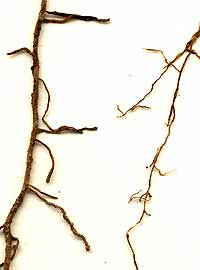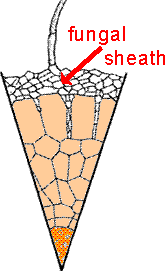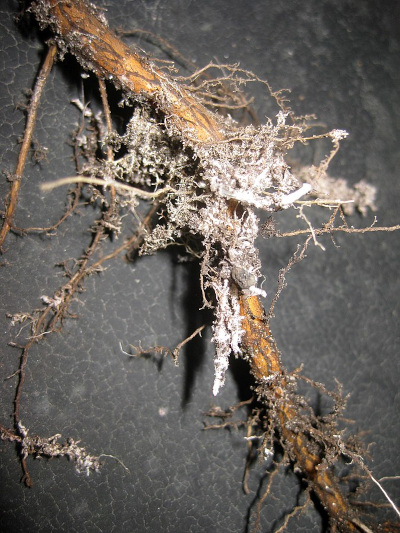(SOURCE: NCBI database)
KINGDOM: Fungi
DIVISIONS:Nearly all the Glomeromycota, and large parts of the Ascomycota and Basidiomycota; About 10% of all identified fungal species are capable of forming mycorrhiza.

From classical Greek, myco means "fungus," and rhiza means "root." Therefore, the word mycorrhiza literally means "fungus-root." When hyphae of certain fungi form specialized sheaths around the roots of certain plants, that fungal root-coating is the mycorrhiza. In the picture of the pine-tree roots at the right, the thicker root is covered with mycorrhiza while the slender root isn't.
Roots covered with mycorrhiza improve many plants' ability to survive droughts, to acquire mineral nutrients, to store carbohydrates, and more.

The drawing at the left shows a cross section of a root with mycorrhiza. The fungal sheath, which constitutes the main body of a mycorrhiza, is a mass of hyphae encasing the root. Filaments of hyphae growing away from the root provide the mycorrhiza more surface area for absorbing water and nutrients.
Mycorrhizae usually are divided into two main types:
ECTOMYCORRHIZAE, whose cells do not penetrate a root's cell walls and enter the cells (as in the drawing). Tree species with ectomycorrhizae include pine, oak, beech, spruce, maple, juniper, willow and elm.
ENDOMYCORRHIZAE, whose cells do penetrate the root's cell walls and enter the cells. Plants with endomycorrhizae include the legumes, grasses, tomatoes, apples, strawberries and peaches.
 Mycorrhizae on roots of European Oak seedling, Quercus robur, in Germany; image courtesy of Wilhelm Zimmerling and Wikimedia Commons
Mycorrhizae on roots of European Oak seedling, Quercus robur, in Germany; image courtesy of Wilhelm Zimmerling and Wikimedia CommonsThough some plants can't survive without mycorrhiza -- certain orchid species, for instance -- most can get along without it. Mycorrhizae simply improve their ability to survive. The hyphae of many kinds of fungus, including some of our most common mushroom producers, form mycorrhizae. Some fungus species form mycorrhizae on the roots of a broad range of plant species, while others "infect" only a few. Similarly, some plants can have any of several fungus species forming mycorrhiza on their roots. Douglas Firs form mutually helpful (symbiotic) relationships with around 2000 fungal species!
- About 10% of all identified fungal species form mycorrhiza
- Nearly all established tree roots have mycorrhiza, and pines can't live without them
- Tree seedlings planted with mycorrhiza on their roots are more resistant to the poisoning effects of heavy metals in the soil
- If global warming gets bad, mycorrhiza may help us by locking huge quantities of carbon dioxide into the soil
- But, air pollution can weaken or destroy mycorrhiza
Here are some specific ways in which mycorrhizae help plants:
- Improved Storage of Carbohydrates: The fungal sheath coating a root acts as a storage site for carbohydrates. Carbohydrates produced by the plant seep into the fungal sheath, which acts as a "sink" the plant can draw from when its own carbohydrate supply runs low.
- Improved Mineral Nutrition: Hypha cell walls which grow away from the root in the manner of root hairs increase the mycorrhiza's surface area, and thus increase the plant's, and its own, access to water and nutrients. Fungal hyphae can migrate through soil absorbing nutrients with only about 1/100th of the energy cost of plants sending their roots there.
- Improved Water Transport: Mycorrhiza increases a root's storage capacity for water, holding water rather like a sponge. When the plant needs water, it can take it from its mycorrhiza.
MYCORRHIZA SOCIALISM
In the early 1990s mycologist Suzanne Simard and her team at Oregon State University discovered that cobwebby networks of mycorrhiza could connect not only many trees of the same species but also trees of different species. They encountered birch connected to fir trees by up to ten different species of fungi. Moreover, birch trees growing in bright sunlight seemed to be subsidizing fir trees in the shade by sharing sugars via their mycorrhizal network.